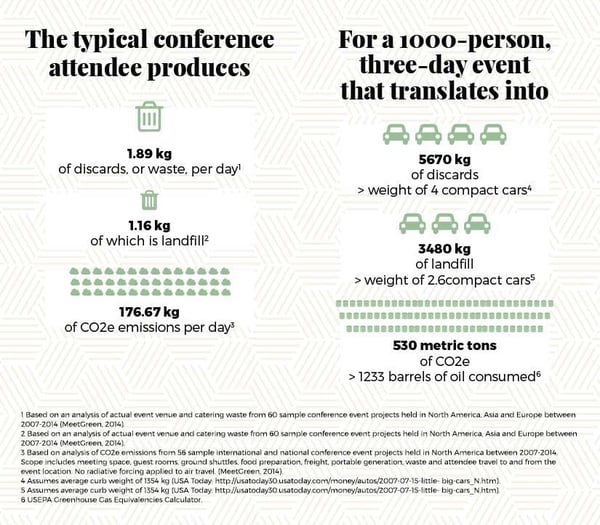December 5, 2019
 by Isabella Sevilla / December 5, 2019
by Isabella Sevilla / December 5, 2019

As an event planner, have you ever asked yourself what impact your events have on the environment and community in general?
Do you know if they are truly sustainable? If you don’t have an answer, let's overview some quick facts on why you should practice sustainable event management.
The average conference participant produces over four pounds of waste at event venues each day. More than 40% of that waste ends up in landfills. As for the event’s carbon footprint, 70% of CO2 emissions come from airplane travel, 15% from lodging, 10% from food and beverage, and 5% from energy requirements.

For all these reasons, it’s undeniable that the event industry has been having a negative footprint in the ecosystem over the past years. That’s why it comes as no surprise to see professionals getting more involved in implementing sustainable efforts in their conferences or events. Nonetheless, there’s still a common fear around the idea that making an event sustainable will add additional expense and time to the companies.
You must be asking by now, will a sustainable event cost me more money? The truth is that with the current technology, it’s not impossible to host an amazing event while reducing the impact on the environment. In this article, I’ll show you step-by-step instructions on how to create green policies to further your sustainable reach. Once you start implementing this process, you’ll realize how rewarding it can be.
The first step that you need to do before trying to improve things is to analyze the impact that your events have on the environment. One effective way to do this is by evaluating each area of your event and looking for ways in which you can make it more environmentally friendly. For this to be effective, the change has to encompass the whole culture of the team, staff, vendors, and sponsors.
You can begin with areas such as:
|
Out of these areas, which one concerns you the most? To make a more significant impact, it’s often good to start with the largest area. For example, if you want to go paperless and eliminate all printed materials, you have to be aware that you’ll need something to take their place, like a mobile event app or an onsite solution provider to ensure attendees have all the information needed.
Now that you know which area you’re going to tackle first, you can start building out a plan. This will help you prioritize the aspects that have the highest importance. Bear in mind that your event budget may not allow you to focus on several areas at once, but don’t allow that to stop you. By just making even just one change, you’re already kick-starting the sustainability levels of your business. Not to mention, creating sustainable events also gives an added value to your brand.
Once you’ve built up your plan, make sure to set some realistic goals that you can improve on each year. Also, you need to set up some deadlines of when you’re going to get everything done. This is important if you actually want to achieve the targets you’ve set.
Similarly, you have to decide on the key performance indicators (KPIs) that you’re going to measure to check whether your plans have worked or not. The KPIs could be anything from the number of plastic items you substituted with biodegradable options or the amount of waste you recycled during the event.
If you want your attendees to be aware of your sustainability efforts, you need to provide a consistent experience and practice green marketing. By involving your partners and vendors into your green approach, you’ll be able to create a cohesive practice, with better and faster results. Make sure you involve them early on, so they can have time to prepare.
With your partners, it is recommended to establish a practical approach, where both parties can bring new knowledge, understanding, insights, and motivation to reduce the negative environmental impacts of events. This approach will help achieve and measure the results of recycling and waste management, energy usage, and economic benefits, among others. In order to successfully achieve a sustainable goal, it's important for you and your partners to share the same values and willingness to actively take part in your sustainability efforts.
Moreover, the vendors you choose to work with will also have an impact on the sustainability of your event. This is why incorporating sustainability into your decision-making process will be essential when choosing a service. You should ask each vendor about their practices to see if they can offer solutions that align with your goals.
To reduce the amount of waste that ends up in the landfill, you can start by providing recycling bins to your attendees. Nowadays this it’s a must-have because most event-goers visit a bin during a show at least once or twice. So, take advantage of the opportunity to show them that you are working on creating a sustainable environment at the events by adding recycling bins in addition to waste bins.
When using recycling bins you have to take into consideration that choosing the right one is important—if you simply use standard bins without any signs that state exactly what needs to go inside, people will fill them with anything and everything. Signage should be clear and bold, so attendees can immediately understand what needs to go in each bin. Try to avoid adding a long list of dos and don’ts, which will only confuse people.
Another action that you can take is to recycle or reuse all the plastic items that are used at the event. Just think of all the errant plastic bags that are left behind—make sure to collect them so they don’t harm the environment. You also have the option to ban the general use of plastic during the event and only provide biodegradable or recycled options to your attendees.
Additionally, you can streamline waste management at your events by contacting non-profits or community programs that accept donations of any leftover conference materials. Another thing that you can do is encourage exhibitors to reduce give-a-ways onsite, as they often end up in the trash. If you make it a constant effort to track what is leftover at the end of your events, you can eventually reduce printed materials, badges, lanyards, etc. Remember, if you reduce the quantity you produce, you save money and space in the landfill.
|
Other ways to manage waste make your event greener:
|
Keep in mind that changing an entire event approach won’t happen overnight—that’s why you have to be patient and start simple. The truth is that creating a sustainable event is going to take time and team effort, but it’s not impossible to achieve. If you start with easier tasks, you’ll be able to implement greener solutions and have a significant positive impact on the environment in no time.
A great way to do this is by implementing green policies. They can help get every stakeholder on the same page and ensure everyone is functioning as one unit so that the entire team knows the environmental standard to adhere to. In the end, this can offer lots of benefits and save costs.
Whatever you do, make sure you are truly committed to making a change. It only takes one person to start making a positive impact, so be the one that pitches the idea of creating sustainable events for your company. After you start implementing these changes, you’ll become more and more aware of the impact of your actions.
The decisions we make today will impact the world for decades to come, so let’s make sure to start making these changes sooner rather than later. Each one of our efforts will help sustain the planet that we live in and ultimately, will help reduce the industry footprint. Hopefully, you can use this article as a guide to help you start creating sustainable events by making your event planning efforts more environmentally-focused.
Isabella is the Content Marketing Specialist at Azavista, an event management platform that covers all needs for event professionals globally. She’s passionate about digital marketing and loves to connect with her audience through quality content. In her free time, she enjoys getting lost in museums, traveling to new places, and learning from different cultures.
Let's be honest — corporate training has a pretty bad reputation. The words alone might...
 by Akanksha Kumari
by Akanksha Kumari
Are you looking for new ways to enhance your event communications to drive early ticket sales,...
 by Elise Hanslip
by Elise Hanslip
At the heart of business growth lies lead generation and pipeline development.
 by Akanksha Kumari
by Akanksha Kumari
Let's be honest — corporate training has a pretty bad reputation. The words alone might...
 by Akanksha Kumari
by Akanksha Kumari
Are you looking for new ways to enhance your event communications to drive early ticket sales,...
 by Elise Hanslip
by Elise Hanslip


